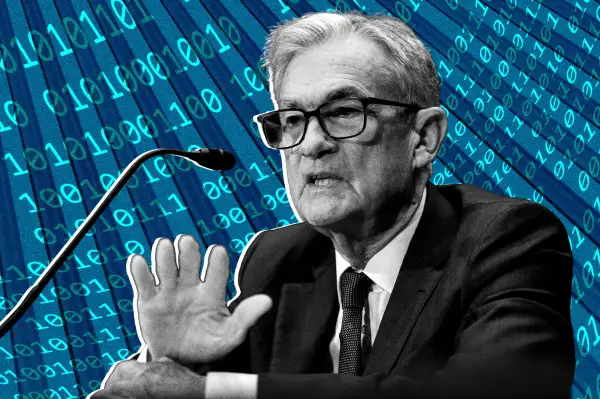Waiting for 0% Interest Rates? Don’t Hold Your Breath

If you’ve been putting off a big purchase because you’re waiting for interest rates to drop back down to pandemic-era lows, you might want to reset your expectations. A new study finds that the probability of the Fed dropping rates to zero again is extremely low.
In a blog post wonkishly titled “The Zero Lower Bound Remains a Medium-Term Risk,” researchers from the New York and San Francisco regional Fed banks discussed two important findings: that officials lowering the benchmark federal funds rate to a range of 0% to 0.25% can’t be entirely ruled out, and that it’s highly unlikely.
Researchers said there’s only a 9% probability that rates will drop back to zero within the next seven years. What's more, given where rates are today — a range of 4.25% to 4.5% — researchers said there's only a 1% chance that rates will hit zero within the next two years.
That's actually a good thing, financial experts say.
"Consumers really don't want interest rates to go back to where they were during the pandemic," Jamie Cox, managing partner at Harris Financial, tells Money. "An economy that relies on ultra-low rates is not a healthy economy." For instance, he points to the ultra-low interest rates of the pandemic years: Housing prices jumped and remain sky-high today.
Plus, people who bought or refinanced in that period now feel "locked in" by their low interest rates, which only exacerbates the shortage of available inventory that began before the Covid pandemic.
The downside of low rates
While people and businesses that need to borrow money — not to mention President Donald Trump — would be thrilled with a fed funds rate that's effectively close to zero, the idea makes economists nervous for a couple of reasons.
Low rates increase demand for goods and services by making it cheaper to finance big purchases. During a recession, this is a good thing. More demand means companies sell more stuff, hire more people and contribute to economic growth. But when the economy is already humming along, a surge in demand is more likely to contribute to inflation — the exact opposite of what the Fed wants to do.
In addition, lowering rates is one of the most important tools the Fed has to pull the economy out of a recession. If the economy tanks at a time when rates can't go any lower, officials can't jumpstart economic growth by making it cheaper to borrow money.
Trump sees it differently. On Wednesday, he took to Truth Social, his social media platform, to engage in one of his favorite hobbies: criticizing Fed Chair Jerome Powell, whom the president has taken to calling “Too Late” in recent missives.
"Our Fed Rate is AT LEAST 3 Points too high. “Too Late” is costing the U.S. 360 Billion Dollars a Point, PER YEAR, in refinancing costs. No Inflation, COMPANIES POURING INTO AMERICA. “The hottest Country in the World!” LOWER THE RATE!!!” Trump posted.
If this sounds like a familiar gripe, that’s because it is. Trump has made frequent complaints about rates being too high and aggressively criticized Powell. Last month, he wrote on Truth Social, "We should be at least two to three points lower...if things later change to the negative, increase the Rate.”
In reality, it’s not so simple, economists say. Policy changes take months, if not longer, to show up in economic data, and the effects can’t be undone with the stroke of a pen or the click of a mouse. In other words, if inflation reached the crippling levels it hit in 2022 — or higher — American shoppers could suffer with months of painfully high prices before anything the Fed could do would make a difference.
For much of modern economic history, 0% interest rates weren’t a thing. By historical standards, today’s rates aren’t even all that high. From 1971 to 2025, the average federal funds rate was 5.41% — almost exactly one percentage point below its current level — according to Trading Economics.
The Fed first slashed interest rates to zero in December 2008, trying to stem the economic fallout from the financial crisis. The benchmark rate would remain at a range of 0% to 0.25% for seven years until the Fed began raising it again. When the pandemic hit in March 2020, the Fed slashed rates to zero once again, a move coupled with unprecedented interventions attempting to stabilize the global financial system.
In March 2022, as it was becoming apparent that rising inflation would not be “transitory,” to use the Fed’s preferred — and subsequently much-maligned — terminology, officials voted to raise rates. That initial hike was followed with a series of rapid, unusually large hikes that brought rates up to a range of 5.25% to 5.5% by July 2023.
A turning tide at the Fed?
Although Powell is unlikely to be swayed by Trump’s all-caps demands, it’s possible that Fed rate activity could become decidedly more Trump-friendly in the future, according to newly released minutes from the Fed’s June meeting. The minutes showed that, while policymakers were unanimous in their vote to leave the fed funds rate at its current range, there was more divergence than usual between officials about where they saw rates going in the future.
In aggregate, officials expect two rate cuts this year and three more within the next couple of years. But the range of outlooks in the "dot plot" — a chart released every three months that includes individual officials’ anonymized expectations — was considerably broader than usual. Dean Smith, chief investment strategist at FolioBeyond, hypothesizes that this could reflect a divergence between policymakers appointed by Trump versus other presidents.
"The sentiment on the Fed is clearly a little mixed," he tells Money. "You can take a very cynical view. There's a couple of folks on the board who would really like Jay Powell’s job."
The two officials who have been most vocally aligned with Trump’s push for lower rates, Michelle Bowman and Christopher Waller, were both appointed to the Fed by the president, and Waller’s name has already been mentioned as a possible candidate for the role of central bank chair when Powell’s term ends next year.
The question at the core of officials’ diverging viewpoints is how much, and for how long, inflation will go up because of tariffs. Bowman and Waller have said more or less the same thing as the White House: Price increases due to tariffs will be limited and temporary. Most economic experts are skeptical of this assertion, especially given the size and scope of Trump’s tariff ambitions.
"Tariffs are inflationary. They just are," Smith says, comparing the White House's viewpoint with the same misguided assessment that pandemic inflation would be transitory back in 2021. "If the tariffs stay in place, it will be inflationary. The Fed as a whole knows this, and that’s why they’re going to wait and see how it goes."
Where does this leave consumers? While a benchmark rate of zero is far and away a long-shot bet, financial pros say consumers can expect to get at least a measure of rate relief later this year.
"The probability is zero we’ll get pandemic-level interest rates," Jay Hatfield, founder and CEO of Infrastructure Capital Management, tells Money. "We're definitely going to get relief almost certainly by September," he predicts.
While Powell has signaled that a July rate cut is probably off the table, Hatfield says the Fed's consensus-minded decision-making process would suggest that cuts are on the way. "He’s going to have to do a pause in July but foreshadow a cut in September to placate those two members," he remarks. "There will be a compromise and that will almost certainly result in two cuts this year and... three cuts next year."
While that might not be enough to get the president to turn off the caps lock, it should give American shoppers and homebuyers a little bit of breathing room.
More from Money:
Waiting for Lower Interest Rates? We Have Bad News
Trump Wants Lower Interest Rates. Here's Why the Fed Isn't Budging




